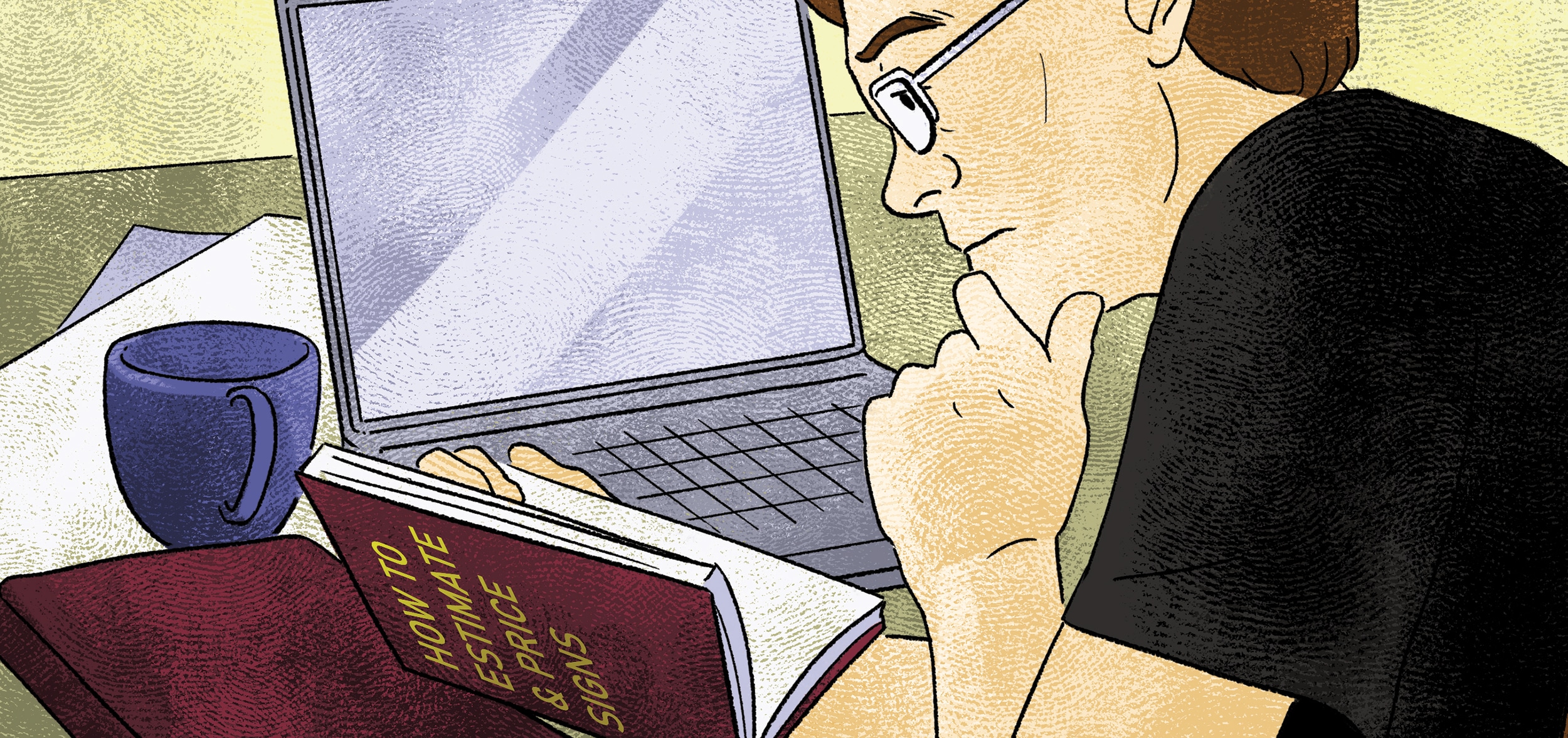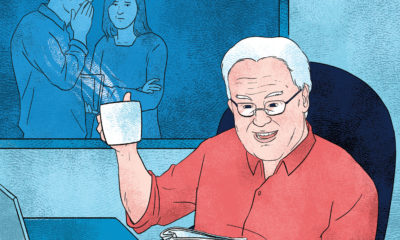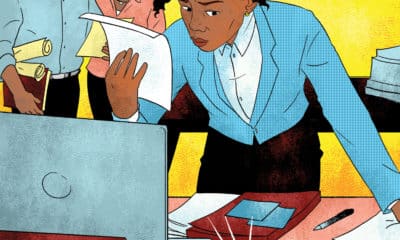
Signshop Takes a Business Risk with Leased Sign
Owner tries out new financial terms, but things don’t go according to plan in “The Case of the Buyer Lease.”
Published
1 year agoon
I GOT THE idea from a book I bought from a skinny guy at the Signs of the Times booth at an ISA show many years ago — How to Estimate & Price Signs. Cost only $20, so I picked it up and started reading on the flight home.
Lots of formulas and things I hadn’t considered, having recently started out. I’d been told to get a copy of that year’s pricing guides to help me know how much to charge, but the guy at the booth talked me into the book instead. I was about to land when I got to the final chapter, on leasing and maintenance. I didn’t think I’d ever — or want to — get into leasing signs, and left it there.
ABOUT REAL DEAL
Real Deal scenarios are inspired by true stories, but are changed to sharpen the dilemmas involved and should not be confused with real people or places. Responses are peer-sourced opinions and are NOT a substitute for professional legal advice. Please contact your attorney if you any questions about an employee or customer situation in your own business.
ABOUT THE AUTHOR
Created by ROLF L’MAO, Signs of the Times’ mascot. Email him at editor@signsofthetimes.com.
Years passed and I was doing real good, but I was trying to break into electric sign fabrication. I’d been selling wholesale, and building a client base but I needed a nudge, maybe a shove, to get me there.
That shove arrived when a new bar, Septimus, was set to open in town. The owner had seen a couple of my wholesale signs and was sent my way. He wanted something custom and unique for his main ID, but the concept turned out to be on the simpler side. “Maybe I can make this one,” I was thinking, when he made another request. “What do you think about monthly payments over, like, five years?”
In order to “do it right,” Septimus’ owner was trying to long-term finance as much as he could, and being upfront about it, he said it was to help keep him solvent. Outright purchases of big-ticket items like the signage for the entire bar were to be avoided. “I’m leasing some of the equipment,” I heard him say, and a light went on in the back of my mind. I told him I’d get back to him.
That night, I read the chapter on leasing and maintenance. This was not a common practice when the book was written — probably still isn’t — but what it said made a whole lot of sense. Leasing would allow me to charge more and have a steady income along the monthly payments. The customer would enjoy the tax advantage of an “advertising expense” versus capital depreciation. Septimus’ owner was open to other lease arrangements, so why not this one?
Next day, I proposed the idea to him. We clarified it would be a lease-to-own but that ownership of the sign would remain in my company’s name until the final lease payment was received — with a term of five years.
Excited by the prospect of trying two new things at once, I really put everything I had into getting this sign right, and I must say, I learned a lot in the process. It took much longer than I had planned, so I was putting in many-a-night and weekend, but as I closed in on finishing, I got a second wind and completed right on schedule.
Septimus also opened on schedule and the entrance sign was a big hit — got some nice publicity from opening-night coverage in the local newspaper and TV. The place turned out to be a bonafide success … and the lease payments rolled in. Nothing to write home about, but something to make me think about maybe offering it again, or even always…
Then, the very day I received payment 40 of 60, two-thirds of the way through, the pandemic restrictions of 2020 were put into effect, and like so many others, Septimus instantly lost all its revenue.
The owner reached out to apologize, “Not my fault, nothing I can do…” and he was right. But I found myself possibly the permanent owner of a sign installed at a bar no one could go to for drinks.
AdvertisementThe Big Questions
- What should this sign company owner do? Leave the sign in place and hope that the lease payments resume and conclude someday?
- Remove it? What about other lease arrangements — could leasing a sign ever be a good idea?
Dan W.
Tucson, AZ
Leave it up; hope for the best. How do you lease a custom sign that is only useful to the end user? If he defaults, you can’t sell it to somebody else. Why extend credit to a new, unproven business? Dumb!
Alan O.
Houston
Why spend the money to remove and store the sign? If the club re-opens he will probably resume payments. If it doesn’t reopen, you may be able to get the removal cost from the next tenant.
Des L.
North Carolina
This is a great case study for a sign lease opportunity. Spreading out and expensing the payments makes good financial sense for the buyer. However, I would not want to tie up my working capital on a five-year sign lease … There are great options to remove the working capital hit from both the buyer and the seller. We’ve worked with leasing companies that specifically offer 100% “SIGN LEASE” with some conditions: mainly minimum value (usually $5K) and a rigid sign. And they offer term flexibility as well, typically 2-5 years. Leasing companies can do deeper dives into a buyer’s financial and credit history and are much better with legal contracts and such to protect all interests. And the best part is you get paid in full right away! And you can still get the price you want. Companies like Geneva Capital make the process easy. Make it win-win-win!
Robert B.
Oakdale, CT
We have actually done some leasing but always with an eye on how long they (the client) will last as a viable business. Our successful leases have been to towns and Chamber of Commerce clients. Our failed leases (we own some signs now with no home but our display area) have been to restaurants and bars. Many only last a year or two. In this case leave it up and pray for the best. Some restaurants/bars have bounced back very well; maybe he will. If you repossess it then you never will see the last 20 payments.
Don P.
Muskogee, OK
Leasing anything is a risk vs. reward proposition. No one has a crystal ball, and it is a risk leasing. That said, there are certain industry types that have a high degree of failure in year one and two, and leasing should be avoided to new businesses in these categories.
Kelley C.
Vancouver, WA
Leave the sign up and hope the bar reopens and starts lease payments again. Definitely won’t get lease payments for a sign sitting in your shop. My rule of thumb: Stick to what you’re good at. Sign companies make signs. Bankers lend money.
Steve A.
St. Louis
I would never lease a sign using my own money. You are a sign company, not a bank. Not to mention a bar has at least a 75% failure rate. Use other people’s money.
Lisa Y.
Springfield, MA
Never lease yourself. Leasing is great if they go through a leasing company. You facilitate the intro and get paid up front and the leasing company is responsible for taking care of collecting. I have used companies in the past and it worked to my advantage. I think this person should leave the sign if the business is open. If it’s closed for good, take the sign down and salvage as much as possible. Either way, the business owes you — on paper — for whatever that’s worth. Perhaps they have something of value you were smart enough to use as collateral and you can put a lien on … but still collecting will be an expense in itself. Maybe he got his expenses out of the deal already and can call it a loss and move on. Lesson learned.
Bob W.
Rochester Hills, MI
I would remove it. Try to make another sign with the frame and sell/lease it to someone else. Give them a discount for taking a sign with a used/refurbished frame. Some income is better than a hope for income. Harder to do with channel letters!
John P.
Illinois
Are you in the sign business or are you in the banking business?
Patrick S.
Omaha, NE
I am not sure how the lease agreement was written. The sign remains the sign company’s property and works for a tax advantage for both parties … But unless you make it clear in the lease, the sign company better carry liability insurance on their own property. A custom sign is of no value if the business closes, so you must have a personal guarantee with personal assets in the lease. If the business closes he still owes the money. If it turns to a personal bankruptcy you may not get much but if the business closes you still have an avenue. If you received 40 payments, you surely should have covered the original cost. The best chance would be to leave the sign up and see if he can come back. While leases can be lucrative, a lot of leasing companies that will do it for you.
Joe F.
Kennewick, WA
It obviously depends on what type of sign it is. If it can be re-used or refurbished simply enough, he should take it down and try to re-sell it. Charge the bar owner for removal and send them to collection for the balance of payments. If it’s a custom sign and isn’t worth re-using, leave it there, but still go after them for payments. If he leased it correctly, he should have already more than broken even after 40 payments. Tell the customer he wants all his top shelf whiskey in trade!
AdvertisementRolf L'mao is Signs of the Times' mascot. Contact Rolf at editor@signsofthetimes.com

SPONSORED VIDEO
Introducing the Sign Industry Podcast
The Sign Industry Podcast is a platform for every sign person out there — from the old-timers who bent neon and hand-lettered boats to those venturing into new technologies — we want to get their stories out for everyone to hear. Come join us and listen to stories, learn tricks or techniques, and get insights of what’s to come. We are the world’s second oldest profession. The folks who started the world’s oldest profession needed a sign.
You may like

NUtec Digital Ink Invests in Solar Energy for Facility

5 Reasons to Sell a Sign Company Plus 6 Options

21 Larry Albright Plasma Globes, Crackle Tubes and More
Subscribe

Bulletins
Get the most important news and business ideas from Signs of the Times magazine's news bulletin.
Most Popular
-

 Tip Sheet2 weeks ago
Tip Sheet2 weeks agoAlways Brand Yourself and Wear Fewer Hats — Two of April’s Sign Tips
-

 Photo Gallery3 days ago
Photo Gallery3 days ago30 Snapshots of the 2024 ISA Sign Expo
-

 Ask Signs of the Times5 days ago
Ask Signs of the Times5 days agoWhy Are Signs from Canva so Overloaded and Similar?
-

 Real Deal2 weeks ago
Real Deal2 weeks agoA Woman Sign Company Owner Confronts a Sexist Wholesaler
-

 Benchmarks1 week ago
Benchmarks1 week ago6 Sports Venue Signs Deserving a Standing Ovation
-

 Paula Fargo16 hours ago
Paula Fargo16 hours ago5 Reasons to Sell a Sign Company Plus 6 Options
-

 Photo Gallery16 hours ago
Photo Gallery16 hours ago21 Larry Albright Plasma Globes, Crackle Tubes and More
-

 Women in Signs2 weeks ago
Women in Signs2 weeks ago2024 Women in Signs: Megan Bradley








